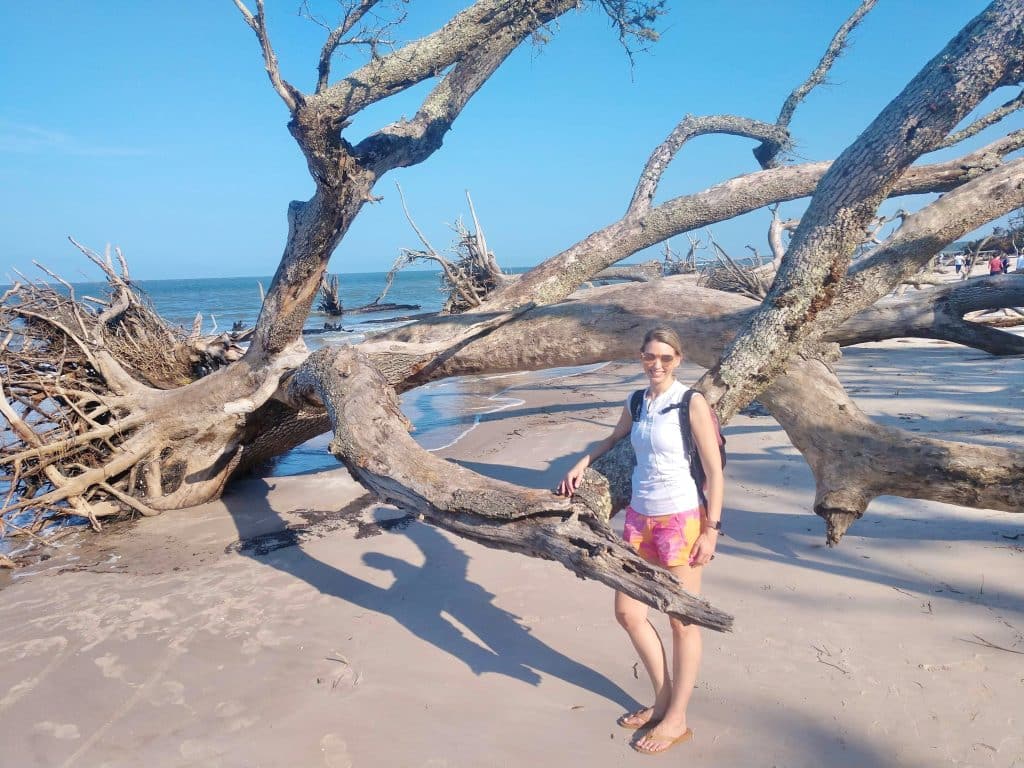
North Florida Land Trust is dedicated to protecting and preserving natural spaces. We conserve and protect forests, agricultural lands, wetlands, coastal marshes, and shorelines. We work alongside others to ensure that wildlife habitats and their important ecosystems remain undisturbed. Partnerships are important to environmental protection. Working together on a common cause brings together resources that one agency or organization might not have on its own.
We are partners in several environmental causes, including the South Atlantic Salt Marsh Initiative, also known as SASMI. NFLT has been a partner in SASMI since the initiative was officially launched in May 2021. Since then, SASMI has been growing steadily, now with more than 300 partners across four states: North Carolina, South Carolina, Georgia, and Florida. This voluntary collaboration connects partners across multiple sectors, including local, state, and federal agencies, nonprofit organizations, cultural groups, recreational groups, landowners, and local communities.
NFLT has a rich history of preserving salt marshes across northeast Florida. Our commitment to protecting salt marshes and enhancing the resilience of coastal communities is a key conservation priority. As the lead organization for SASMI in Florida, NFLT plays a pivotal role. Heather Nagy, our strategic conservation planning coordinator, leads the Florida State Implementation Team for SASMI. We asked Heather to share more about the initiative and its significance for Florida.
Why is protecting salt marshes so important?
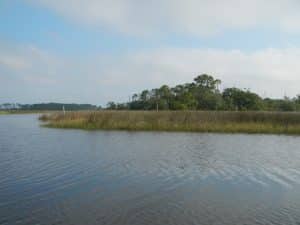 Salt marshes may look like simple grasses, but they are incredibly productive and important ecosystems. They protect coastlines from flooding, erosion, and storm surge, filter upland runoff, and serve as vital habitats for fish, birds, and other animals. Salt marshes also house many sites of cultural and spiritual significance.
Salt marshes may look like simple grasses, but they are incredibly productive and important ecosystems. They protect coastlines from flooding, erosion, and storm surge, filter upland runoff, and serve as vital habitats for fish, birds, and other animals. Salt marshes also house many sites of cultural and spiritual significance.
Salt marshes provide shelter, food, and nursery grounds for more than 75% of Florida’s commercial and recreational fish species, including shrimp, blue crab, redfish, and flounder. Florida would not be a fisherman’s paradise without salt marshes. They also keep our water clean by filtering nutrients, pollutants, and sediment.
Finally, salt marshes protect our coastline and local communities from storms and coastal flooding. They absorb flood waters and wave energy, decreasing property damage in adjacent communities by up to 20%. Salt marshes can absorb up to 1.5 million gallons of floodwater during storm surges, providing a critical buffer to homes and businesses during storm events.
What are the goals of SASMI?
SASMI’s goal is to conserve and restore the approximately 1 million acres of salt marshes within the South Atlantic states to ensure their long-term survival and to protect the benefits these wetlands provide for fish, wildlife, and people. In May 2023, SASMI released a long-term, regional salt marsh protection plan entitled “Marsh Forward: A Regional Plan for the Future of the South Atlantic Coast’s Million-Acre Salt Marsh Ecosystem.” This plan was developed with input from a wide variety of stakeholders and serves as a comprehensive and forward-thinking guide for future development, restoration projects, land conservation, and species protection that will promote healthy and resilient coastal marshes.
Heather, you lead the recently created state implementation team for SASMI, can you tell us a little more about the team and its efforts?
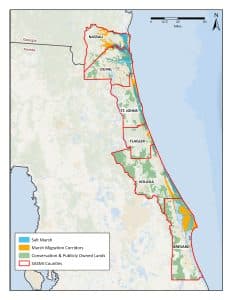 While the SASMI regional plan outlines important strategies, objectives, and actions aimed at protecting and restoring salt marshes, most of the plan’s implementation will occur at the state and local levels. The success of the SASMI regional plan relies on the establishment of teams within each SASMI state tasked with identifying and executing priority actions. The Florida State Implementation Team (FSIT) will lead SASMI’s on-the-ground implementation efforts in Florida.
While the SASMI regional plan outlines important strategies, objectives, and actions aimed at protecting and restoring salt marshes, most of the plan’s implementation will occur at the state and local levels. The success of the SASMI regional plan relies on the establishment of teams within each SASMI state tasked with identifying and executing priority actions. The Florida State Implementation Team (FSIT) will lead SASMI’s on-the-ground implementation efforts in Florida.
NFLT has just begun efforts to convene a diverse group of partners who will work together to identify and prioritize specific long- and short-term projects that will advance salt marsh protection and restoration throughout Northeast Florida. The FSIT partners will then work to fund and implement those projects, completing on-the-ground actions to achieve the goals of the SASMI regional plan. These partners represent multiple sectors and interests, including state agencies, the Department of Defense, local counties and municipalities, mosquito control districts, nonprofit organizations, cultural groups, recreational fishermen, and landowners, to name a few. The FSIT is designed to be complementary to existing projects and efforts partners are already undertaking throughout the region. The team will facilitate collaboration and communication amongst partners to maximize their collective efforts.
What kind of work needs to be done?
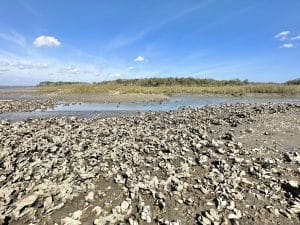 The FSIT already has some projects in the pipeline as we work to stand up the team. In December, the SASMI partnership received a grant from the National Fish and Wildlife Foundation’s National Coastal Resilience Fund to undertake planning and capacity building in vulnerable communities in the Southeast. NFLT and the Northeast Florida Regional Council are the lead organizations for this project in Florida. Over the next two years, we will collaborate to host community meetings throughout Northeast Florida to identify five to six project areas where we can implement nature-based solutions to preserve or restore salt marsh while increasing the benefits to the local community. Additionally, the FSIT is building a partnership with the Florida Aquatic Connectivity Team to identify specific areas where aquatic connectivity can be improved through barrier removal or restoration.
The FSIT already has some projects in the pipeline as we work to stand up the team. In December, the SASMI partnership received a grant from the National Fish and Wildlife Foundation’s National Coastal Resilience Fund to undertake planning and capacity building in vulnerable communities in the Southeast. NFLT and the Northeast Florida Regional Council are the lead organizations for this project in Florida. Over the next two years, we will collaborate to host community meetings throughout Northeast Florida to identify five to six project areas where we can implement nature-based solutions to preserve or restore salt marsh while increasing the benefits to the local community. Additionally, the FSIT is building a partnership with the Florida Aquatic Connectivity Team to identify specific areas where aquatic connectivity can be improved through barrier removal or restoration.
Finally, NFLT received grant funds from NOAA and the Florida Department of Environmental Protection to acquire salt marsh properties within the Northeast Florida Blueway Florida Forever project area, located in Duval and St. Johns Counties. The FSIT will continue to champion a wide variety of projects that aim to increase the long-term health and resilience of Northeast Florida’s salt marshes.
What is the biggest threat to salt marshes?
Though salt marshes are critically important ecosystems and provide a wide variety of benefits, they also face a number of threats, including rising seas, polluted runoff, and encroaching development. Large extents of salt marshes in Florida have been lost over time due to coastal development and dredge-and-fill activities. Although state and federal laws have greatly minimized outright destruction of marsh, water flow modifications and pollution from coastal and inland communities, including industrial chemicals, road runoff, fertilizer, and pesticides, can significantly impact marsh function and lead to marsh loss.
Additionally, as sea levels rise, salt marshes need space to migrate inland; otherwise, they will drown under rising waters. Increased coastal development is eliminating these undeveloped migration corridors, leaving the marsh with nowhere to go.
What can the average person do to help the initiative?
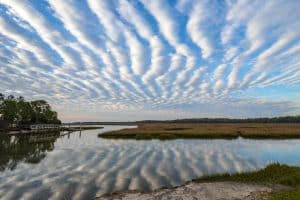 There are many ways the average person can help salt marshes. One thing you can do is be conscious of fertilizer and pesticide use on your property. Use fertilizer and lawn care products sparingly, only as directed, or not at all. When it rains, water falling on your yard picks up these pollutants and carries them to streams and waterways, affecting wildlife and ecosystems far from your home.
There are many ways the average person can help salt marshes. One thing you can do is be conscious of fertilizer and pesticide use on your property. Use fertilizer and lawn care products sparingly, only as directed, or not at all. When it rains, water falling on your yard picks up these pollutants and carries them to streams and waterways, affecting wildlife and ecosystems far from your home.
If you need to fortify your property from marsh or other waters, consider using nature-based solutions, such as living shorelines, instead of hardened infrastructure like seawalls. In many cases, these natural barriers can protect your property better than a seawall, which can not only degrade over time but also interfere with healthy salt marsh function.
Protecting salt marshes and their migration corridors is vitally important in ensuring the long-term survival of the salt marsh ecosystem. If you have a marsh or marsh-adjacent property you are interested in conserving, reach out to a conservation organization like NFLT, which can help you ensure long-term protection of the property.
Finally, research and learn about regulations and conservation efforts aimed at salt marshes and wetlands, and share your knowledge with friends, family, and your neighbors. We can all “marsh forward” and be a part of protecting salt marshes and their many benefits for people, fish, and wildlife here now and in the future!






